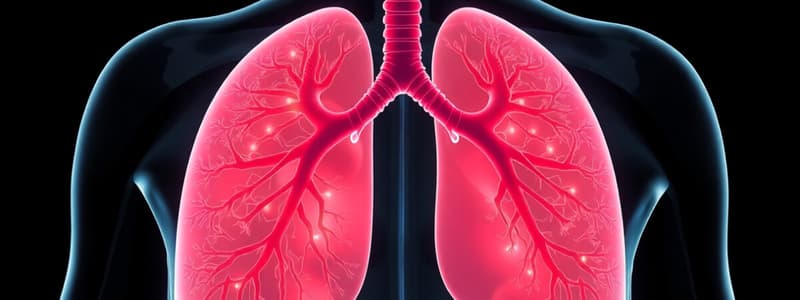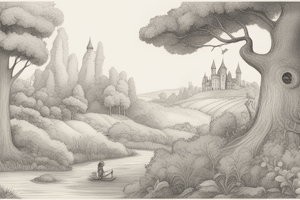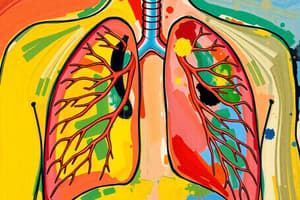Podcast
Questions and Answers
Describe the role of the alveoli in gas exchange. How are their structures adapted for this function?
Describe the role of the alveoli in gas exchange. How are their structures adapted for this function?
Alveoli are tiny air sacs in the lungs where oxygen from inhaled air diffuses into the blood, and carbon dioxide from the blood diffuses into the alveoli to be exhaled. They are adapted for gas exchange by being thin-walled (one cell thick), having a large surface area, and being densely surrounded by blood capillaries for efficient gas exchange.
What is the primary function of the circulatory system? How do the different types of blood vessels contribute to this function?
What is the primary function of the circulatory system? How do the different types of blood vessels contribute to this function?
The circulatory system's main function is to transport oxygen, nutrients, and waste products throughout the body. Arteries, with their thick walls, carry oxygen-rich blood away from the heart at high pressure. Veins, with thinner walls and larger lumens, carry oxygen-poor blood back to the heart. Capillaries, the smallest vessels, connect arteries to veins and allow for the exchange of gases, nutrients, and waste products between blood and tissues.
Explain how the respiratory system responds to exercise. What changes occur in breathing and why?
Explain how the respiratory system responds to exercise. What changes occur in breathing and why?
During exercise, the body's demand for oxygen increases. To meet this demand, the respiratory system responds by increasing breathing rate to deliver more oxygen to the lungs. Additionally, breathing becomes deeper, allowing for greater oxygen intake. This increased oxygen intake and removal of carbon dioxide helps the body sustain the increased energy needs of exercise.
What are the key organs involved in the digestive system and what is the role of each organ in breaking down food?
What are the key organs involved in the digestive system and what is the role of each organ in breaking down food?
Describe the role of the diaphragm in the process of breathing. Explain how it contracts and relaxes during inhalation and exhalation.
Describe the role of the diaphragm in the process of breathing. Explain how it contracts and relaxes during inhalation and exhalation.
What are the main components of blood and what are their respective functions?
What are the main components of blood and what are their respective functions?
How does the circulatory system respond to exercise? What happens to heart rate and blood flow?
How does the circulatory system respond to exercise? What happens to heart rate and blood flow?
How does the endocrine system contribute to the overall regulation of the body's functions? Provide an example.
How does the endocrine system contribute to the overall regulation of the body's functions? Provide an example.
Flashcards
Function of the Respiratory System
Function of the Respiratory System
Provides oxygen to the body and removes carbon dioxide.
Main Organ of Gas Exchange
Main Organ of Gas Exchange
Lungs are the main organ where gas exchange happens.
Role of Alveoli
Role of Alveoli
Tiny air sacs where oxygen enters the blood and carbon dioxide leaves.
Adaptations of Alveoli
Adaptations of Alveoli
Signup and view all the flashcards
Function of the Digestive System
Function of the Digestive System
Signup and view all the flashcards
Main Organ of Circulatory System
Main Organ of Circulatory System
Signup and view all the flashcards
Red Blood Cells
Red Blood Cells
Signup and view all the flashcards
Function of the Endocrine System
Function of the Endocrine System
Signup and view all the flashcards
Study Notes
Respiratory System
- Function: Provides oxygen to the body and removes carbon dioxide.
- Main Organs:
- Lungs: Main organ where gas exchange occurs.
- Trachea: Air passes through here to reach the lungs.
- Bronchi & Bronchioles: Tubes that direct air into the lungs.
- Alveoli: Tiny air sacs where oxygen enters the blood and carbon dioxide leaves.
- Alveoli adaptations: One cell thick to allow easy gas exchange; blood capillaries to allow diffusion of gases in and out of blood; large surface area to allow fast exchange of gases.
- Diaphragm: Muscle that helps in breathing.
- Process:
- Oxygen is inhaled into the lungs.
- Oxygen diffuses into the blood at the alveoli.
- Carbon dioxide is removed from the blood and exhaled.
- During Exercise:
- Breathing rate increases to supply more oxygen.
- More carbon dioxide is removed.
- Deep breathing helps improve oxygen intake.
Digestive System
- Function: Breaks down food into nutrients the body can use.
- Main Organs:
- Mouth: Breaks down food using teeth and saliva.
- Esophagus: Moves food to the stomach.
- Stomach: Uses acid and enzymes to digest food.
- Small Intestine: Absorbs nutrients into the blood.
- Villi adaptations: Thin walls, large surface area, blood capillaries.
- Large Intestine: Absorbs water and forms waste.
- Liver & Pancreas: Help digest fats and regulate blood sugar.
Circulatory System
- Function: Transports oxygen, nutrients, and waste around the body.
- Main Organs:
- Heart: Pumps blood around the body.
- Blood Vessels:
- Arteries: Thick walls to withstand high pressure; small lumen; carry oxygen-rich blood away from the heart.
- Veins: Thin walls, large lumen; carry oxygen-poor blood back to the heart.
- Capillaries: Tiny network of vessels where gas exchange happens; connects veins to arteries.
- Blood Components:
- Red Blood Cells: Carry oxygen.
- White Blood Cells: Fight infection.
- Platelets: Help with blood clotting.
- Plasma: Carries nutrients and waste.
- During Exercise:
- Heart rate increases to pump more oxygen to muscles.
- More carbon dioxide is removed through the lungs.
Endocrine System
- Function: Produces hormones to regulate body functions.
- Main Glands & Hormones:
- Pancreas: Produces insulin to control blood sugar.
- Adrenal Glands: Produce adrenaline for the "fight or flight" response (excited, scared). Increases heart rate; boosts energy supply; helps react quickly.
- Thyroid: Produces thyroxin; regulates metabolism.
- Pituitary Gland : Controls other glands, produces growth hormone and antidiuretic hormone.
- Reproductive glands: (Ovaries in females): produces estrogen and progesterone. Testes in males: produces testosterone.
Nervous System
- Function: Controls body movements and responses.
- Main Parts:
- Brain: Processes information and controls actions.
- Spinal Cord: Sends signals between the brain and body.
- Nerves: Carry messages to and from the brain.
- Neurons:
- The nerve cell - Made up of cell body, dendrites, axon and myelin sheath.
- Thin projections called dendrites extend from the cell body and connect with other neurons, allowing electrical impulses to pass from one to the other.
- Types of Responses:
- Voluntary – Controlled movements (e.g., catching a ball).
- Reflexes – Automatic responses (e.g., pulling hand away from heat).
Reflex Arc Response
- Stimulus picked up by receptor cells in finger (skin).
- Impulse passed on to sensory neurons.
- Sensory neurons pass impulse to spinal cord.
- Spinal cord sorts out (relays) a response and sends a message to motor neurons.
- Motor neurons tell the muscle (effector) to contract.
- The finger moves away from the stimulus.
Studying That Suits You
Use AI to generate personalized quizzes and flashcards to suit your learning preferences.




